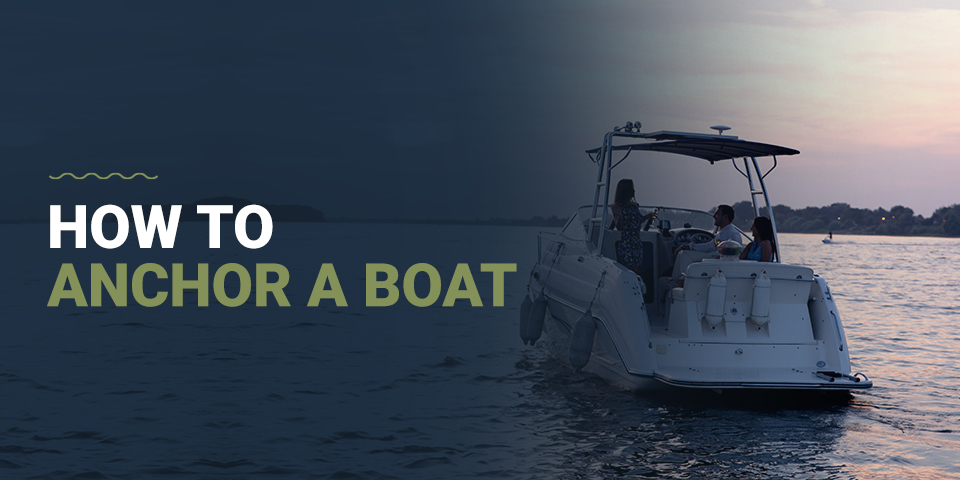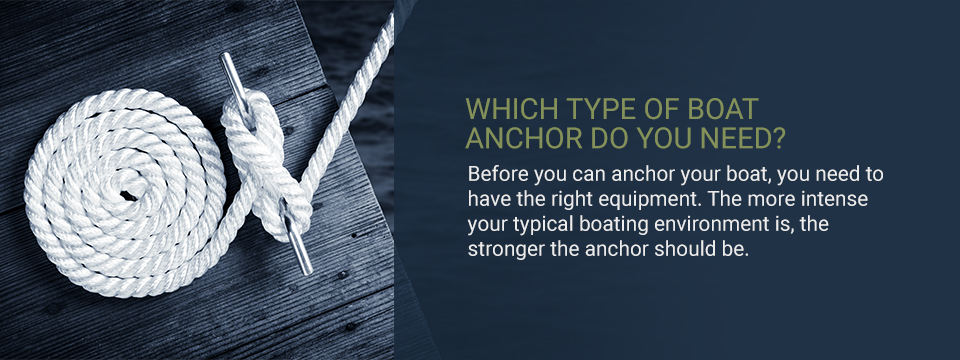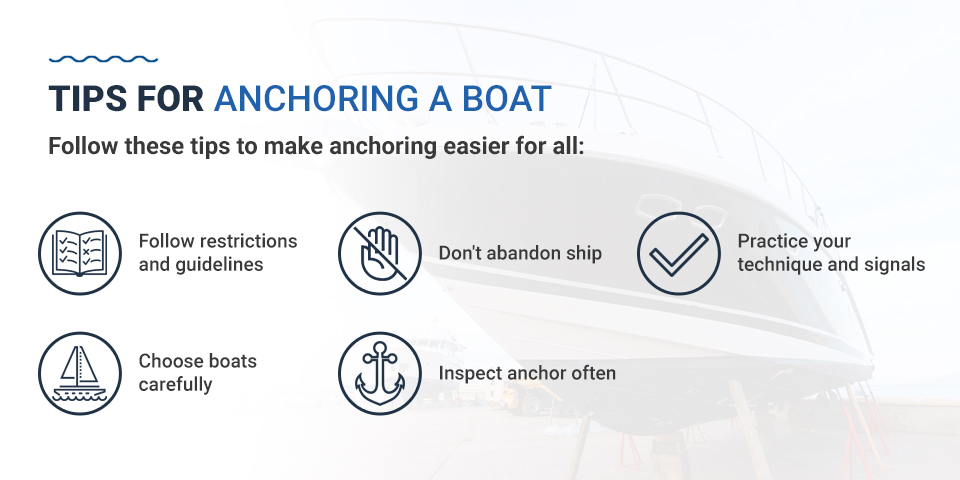Filters
How to Anchor a Boat Properly
A Step by Step Guide on Anchoring and Best Boating Practices
Boating experts and federal law recommend you carry at least one sufficiently sized anchor onboard your vessel. The anchor should be the right type for your boat and the conditions where you’re traveling. More than one anchor is advisable when possible.
Anchoring is different from mooring and docking because, instead of tying your boat to a dock or other stationary item, you use your anchor and line to hold your vessel in place on the open water.
The following circumstances require the use of an anchor:
- When anchoring your boat in open water overnight.
- When stopping your vessel to fish, swim or take in the sights.
- When seeking shelter from a storm on the open water.
Though boat anchoring is second nature for many, improper anchoring techniques can be dangerous. The U.S. Department of Homeland Security and U.S. Coast Guard report loading passengers and gear into an improperly anchored boat was a leading cause of boating deaths and accidents in 2019.
Here’s what you need to know about how to anchor a boat and advice for practicing good boating etiquette on the water.
Read the full article or jump to a specific section:
- Determine Your Boat Anchor Type
- Which Type of Boat Anchor Do You Need?
- Steps to Properly Anchoring a Boat
- Retrieving the Anchor
- Common Mistakes to Avoid
- Tips for Anchoring a Boat
- Practice Good Anchoring Etiquette
Determine Your Boat Anchor Type
Successful anchoring relies on having the right equipment for your boat. Consider the following factors when choosing your anchor:
- Your vessel: The larger the vessel, the heavier anchor it needs. Small and recreationally-sized boats can typically get by with smaller anchors, though it depends on your vessel’s total weight.
- The water: The type of floor beneath the body of water you traverse is one of the most important factors to consider. Different anchors are designed to accommodate sandy, muddy, rocky, and grassy floors. Though most are made of resilient stainless steel, aluminum, or galvanized metal, always make sure your anchor’s makeup can withstand your water conditions and won’t deteriorate in saltwater. If you plan to anchor in multiple bodies of water, invest in an anchor that can withstand various floor conditions or keep a few different types on hand for multiple settings and occasions.
- Environmental conditions: Environmental conditions that affect anchoring needs include tides, strong wind resistance, and whether waves are calm or tumultuous.
Which Type of Boat Anchor Do You Need?
Before you can anchor your boat, you need to have the right equipment. The more intense your typical boating environment is, the stronger the anchor should be. Consider if your body of water is calm — average wind and minimal waves or movement — or tumultuous — faced with high winds and waves or strong currents. Anchors for calm waters and small vessels are called lunch hooks and are a good fit if you plan to monitor your vessel while anchored. For stronger conditions or unmonitored anchoring, look for a storm anchor that can withstand high wind movement.
Here’s a brief guide for choosing the best anchor for your vessel — when in doubt, consult your boat’s user manual for further guidance or specific recommendations.
Anchors by Floor Type
If you’re not sure what type of floor your lake, river or beach has, ask local rangers or coastal guards. Some bodies of water have multiple floor conditions, depending on depth and location, so choose your anchor by the areas you boat in most often:
- Hard sand or mud: Lightweight and Danforth anchors are ideal for recreational vessels 21 feet and under boating in hard sand or thick mud because they have long flukes that resist buildup or suction. They’re available in a wide range of weights.
- Grass or rocks: Though mostly used by large ships, Kedge and Navy anchors are shaped to grip the floor in weeds, grass, or rocky conditions.
- Varied conditions: For varied bottom conditions, look for a Plow/CQR or Delta anchor. Plow anchors are good for cruising boaters because they grip the floor once moved and adapt to changing environmental conditions. For vessels between 21 and 50 feet, a Delta is good for most conditions.
A grapnel anchor is a small, cost-efficient unit you can use for low-intensity rivers, canoeing or to help retrieve things from shallow-water floors.
Some Anchoring Terminology
Before we dive into how to anchor a boat, let’s brush up on some common terminology:
- Cleat: Cleats are the part of your boat — or dock — where you attach anchor or mooring lines. They’re usually metal but may also be wood or nylon. Inspect them for stability before anchoring.
- Shank: The shank is the long stem at the top of the anchor.
- Flukes: Flukes are the individual, often angled, parts of the anchor that bury into rocks, mud, dirt, clay, and sand.
- Rode: The rode is the anchor line, which is either rope, chain, or a combination of both.
- Scope: Scope is the calculation you make to determine the best pull angle for the anchor. It refers to how many feet of rode you need to let out for each foot of water depth. Experts recommend a scope ratio of at least 5-1, 7-1, or 8-1 if you can.
- Ground tackle: Ground tackle is the general, all-encompassing term for the equipment — anchor, rope, chain, and connecting elements — you need to anchor your vessel.
- Holding power: When shopping for anchors, you’ll notice a “holding power” rating, which tells you much weight the anchor can support.
Steps to Properly Anchoring a Boat
Anchors work by sinking to the floor of the ocean, river, or lake beneath your boat and gripping or burrowing into the surface there. As wind and waves move your vessel, the anchor holds, strengthening its grip and creating a resistance in the rode.
Follow these steps to anchor your boat:
- Choose your spot: Carefully assess your surroundings before choosing your anchoring spot. Look for areas safe for boating but shallow enough for easy anchoring with minimal rode. Avoid reefs, habitats, or excessive rocks. If winds are high, anchor your boat on the opposite side of something that can break that movement, like an island with trees or a rock formation. If you’re in a popular boating or anchoring area, avoid other boaters and keep a safe distance between vessels. You should head into the current when anchoring, but if winds are too rough, let your vessel drift back naturally first for an accurate radius of movement.
- Wear protective gear: Each person helping to anchor the vessel should wear a life jacket or other personal flotation device (PFD) before beginning. If you’re anchoring in heavy waves, currents, or otherwise unsafe conditions, instruct passengers to do the same.
- Reduce and reverse: Ease your throttle, reverse your engine and reduce your speed until you reach a near standstill.
- Tie line to bow cleat: Secure your line to the cleat at the boat’s bow. Double-check the strength before continuing — many boaters lose anchors as a result of loose line or weak knots. If you’re anchoring overnight, add a chain to your rode that equals one-half of the boat’s length.
- Lower the anchor: Slowly and carefully lower the anchor into the water until about one-third of the line is submerged. Do not throw your anchor or drop all of the line at once. Avoid leaning over the side of the boat and always keep one hand firmly on the railing.
- Test the anchor: Once your anchor hits the floor below, gently pull on it to assess its stability and grip before releasing the rest of the rode.
- Let out scope: Calculate your scope — ideally, an 8-to-1 ratio — and let it out.
- Check for drag: Once you’ve set your anchor, check for any drag with a depth sounder, if possible. Some technology may have an anchor alarm system you can set to alert you of possible dragging.
- Get your bearings: Take your bearings by choosing at least two permanent landmarks or fixtures, like a mountain formation on the horizon or a building on a nearby shore, and note the distance between those points and your vessel. Use these bearings to keep track of your boat’s movement — including any dragging — while anchored.
While anchored, keep a close eye on your line and location. Make sure your rode is in-tact and not fraying or at risk for snapping. Check your bearings often and note any abnormal movement or drifting.
Retrieving the Anchor
When it’s time to retrieve your anchor, slowly make your way toward it and stop your vessel directly over it. Put on your life jacket or PFD and grip the line near the cleat and slowly pull the rode onboard. Be careful not to swing or drop the anchor onboard. Do your best not to drag the anchor across the seafloor, lake floor, or riverbed, as it could snag on rocks and weeds or disrupt fish habitats.
Try these methods for loosening and removing your anchor if it gets stuck:
- Turn the boat: Change your boat’s direction by idling into the wind or turning in a circle. Ask someone to hold the rode and attempt to pull the anchor in while you move your vessel in the opposite direction.
- Add tension: If moving your boat didn’t help loosen the anchor, you might need to add tension to the rode. Do this by holding the line firmly in your hands and wrapping it once more around the same cleat. Continue pulling and keep tension in the line while allowing the wind and water’s natural movement to dislodge the anchor.
- Use a retrieval ring: Use an anchor retrieval ring and buoy to create a pulley-like system that pulls the anchor from weeds or rocks. You can find these and similar tools at boating equipment stores.
If the water is safe, calm, and shallow enough, you may be able to retrieve your anchor by hand by diving or snorkeling to dislodge it — just know your limits and don’t engage in dangerous behavior. Never try this method if you’re boating alone. If all else fails, you can cut your line and chalk the anchor up to a loss. If this is a place you go boating often, note the location and GPS coordinates to avoid anchoring there in the future.
Common Mistakes to Avoid
Unfortunately, anchoring missteps can lead to a lot of danger and property destruction. Protect yourself, your vessel, and other boaters by avoiding these common anchoring mistakes:
-
- Tangling the line around people and items: Keep all items out of the anchor line’s path, including coolers, shoes, towels, fishing gear, and flotation devices. Make sure all people onboard keep a safe distance so their arms or legs don’t get tangled in the rope.
- Anchoring by the stern: Never tie your rope or chain to the stern or lower the anchor here. You risk taking on water, swamping, capsizing, or moving into the wind.
- Forgetting extra supplies: Invest in a backup anchor and line and keep them onboard. This way, should you lose your anchor to the mud or rocks below, you still have a way to anchor without returning to shore.
Tips for Anchoring a Boat
It’s not enough to know how to anchor a boat — you also need to put knowledge into action. Practice your anchoring technique before you hit the water and teach others onboard the steps they need to know to stay safe and keep the boat secure.
Follow these tips to make anchoring easier for all:
- Follow restrictions and guidelines: Depending on where you’re boating, there may be state, local, or private water regulations or anchoring restrictions. Follow any visible markers and stay up-to-date on guidelines.
- Choose boats carefully: For easy anchoring, make sure a boat has features like a bow rail, secure cleats, an anchor locker, and a chain stop before investing in a new vessel.
- Don’t abandon ship: Never leave your boat anchored in the same spot for too long, especially if you’re in a public access area. Monitor your anchored vessel whenever possible, and be mindful of other boaters who may be waiting to anchor nearby. If anchoring overnight, do so in a safe, approved area and monitor your line as often as possible.
- Inspect anchor often: Inspect your anchor and line for damage or deterioration before each boat outing. Repair or replace as needed.
- Practice your technique and signals: If you own a sizeable recreational vessel or ship, clear communication is critical for the safety of you, your crew, and passengers. Have a plan in place and practice your anchoring techniques. Establish both verbal and nonverbal signals for when the anchor is being lowered or raised or when it’s stuck.
Practice Good Anchoring Etiquette
If you’re anchoring near other boaters — like at a popular swimming hole, fishing hotspot, or overnight anchoring location — let others know you’re anchoring with an anchor buoy. The buoy attaches to your rode and tells other boaters to be careful and avoid anchoring their own vessels on or near your setup.
For a fun, safe experience for all, be sure to practice good anchoring etiquette:
- The first boat in sets the precedent: If you’re not the first one to anchor in a location, follow what the other boaters are doing, including how they’ve set their anchor and how much space exists between boats. Pay attention to what other boaters are doing — for example, if everyone in a cove is fishing, you don’t want to anchor there for a dip in the water and vice versa.
- Keep your distance: Maintain a safe, comfortable distance from others anchored nearby to avoid drifting into a collision. This is also a good way to cut down on noise pollution and ensure everyone has enough privacy to enjoy their break.
- Manage your noise level: Booming speakers and yelling passengers might be telltale signs of a good time, but be respectful of others anchored nearby. Keep your volume at a reasonable level and avoid making noise after dark, which could disturb others who may be sleeping.
- Don’t discard food or trash: Don’t toss your unfinished food, drink or trash over the side of your boat — regardless of where you’re anchored and who is around. Littering looks bad, pollutes the water, and could harm wildlife. It’s also illegal or against guidelines on most waterways.
- Be mindful after dark: Many boaters anchor at night to get some sleep, so pay attention to where your lights are shining and how bright they are.
- Go slow and avoid waves: When entering an area with other anchored boaters, lower your speed and avoid waking. Entering at high speed and creating waves is more than rude — it’s also dangerous for anyone who might be swimming or fishing nearby.
Anchoring is a great time to meet fellow boaters and make new friends. Some places may host fun gatherings at popular anchor locations, where you can take a break from cruising and focus on having fun and relaxing after a day in the sun.
EZ Dock Boat Docks Make Docking Simple
EZ Dock floating docks make it easier than ever to moor your boat. We’ve designed all of our dock sections and EZ BoatPorts®, products, and accessories out of resilient, low-maintenance materials you can easily configure into your existing property. Pair your floating dock with our reliable dock cleats for simple long-term or short-term mooring.
Request a quote today and learn more about securing an EZ Dock floating dock for your commercial, industrial, governmental or residential property!















